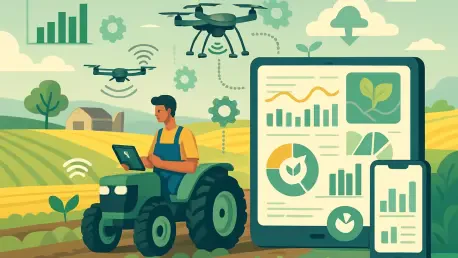The agricultural landscape is undergoing a profound shift as data-driven technologies take center stage, with the global AgriTech data management and analysis market projected to grow from $3.2 billion in 2024 to an astounding $10.2 billion by 2035, highlighting the critical role of advanced tools. Innovations like IoT sensors, satellite imagery, and AI algorithms are becoming essential in addressing some of the most pressing challenges facing modern farming. Climate volatility, food security concerns, and the push for sustainable practices are driving farmers to abandon traditional, intuition-based methods in favor of real-time, evidence-based decision-making. From monitoring crop health to optimizing livestock nutrition, these technologies are not just enhancing productivity but redefining the very nature of agricultural operations. As digital transformation becomes a necessity rather than a choice, the market’s rapid expansion signals a future where data analytics is the backbone of farming, promising efficiency and resilience in an increasingly unpredictable world.
Market Drivers and Growth Factors
Climate Challenges and Food Security
The unrelenting impact of climate volatility is a primary force propelling the adoption of data analytics in agriculture, as farmers grapple with unpredictable weather patterns, prolonged droughts, and devastating pest outbreaks that threaten yields. Predictive analytics, powered by advanced algorithms and real-time data from sensors, offers a lifeline by enabling proactive risk mitigation. For instance, farmers can now anticipate adverse weather events and adjust planting schedules or irrigation plans accordingly, minimizing losses. Beyond immediate threats, the broader challenge of global food security looms large, with a growing population demanding more efficient production. Data-driven solutions help maximize output on limited land by optimizing resource use, ensuring that every drop of water and ounce of fertilizer contributes to higher yields. This alignment with sustainability goals, often mandated by stricter regulations, further accelerates the shift toward tech adoption, as stakeholders recognize the dual benefit of meeting demand while reducing environmental harm.
Another dimension of this driver lies in the urgency to balance productivity with ecological responsibility, a balance that data analytics is uniquely positioned to achieve. Governments and international bodies are increasingly enforcing policies that require reduced carbon footprints and minimized resource waste, pushing the agricultural sector to innovate. Digital tools enable precise application of inputs like pesticides and fertilizers, cutting down on overuse that harms soil and water systems. Moreover, the integration of climate-smart technologies allows for better tracking of emissions, helping farms comply with regulatory standards. The intersection of these imperatives—combating climate risks and securing food supplies—creates a compelling case for investment in AgriTech solutions. As the market responds to these pressures, it becomes clear that data management is not merely a tool for efficiency but a critical strategy for survival in a world where environmental and demographic challenges are intensifying.
Government and Regulatory Support
Government initiatives across the globe are acting as powerful catalysts for the growth of data-driven agriculture, providing both funding and frameworks to encourage technology adoption. In North America, the U.S. Department of Agriculture’s $3.1 billion Climate-Smart Commodities program stands out as a landmark effort, equipping thousands of farms with tools to reduce input usage while maintaining productivity. Similarly, Canada’s substantial investments through programs like the Canadian Agri-Food Automation and Intelligence Network are fostering innovation by supporting AI and automation projects. These efforts not only provide financial backing but also build trust in new technologies by demonstrating tangible benefits through pilot programs. Such public-sector involvement lowers the entry barrier for farmers hesitant about costs, creating a ripple effect that drives market expansion as more players see the value of data analytics in real-world applications.
Beyond North America, regulatory frameworks in Europe are shaping the AgriTech landscape by aligning innovation with sustainability goals, ensuring that technology serves broader environmental objectives. Policies that incentivize reduced emissions and resource conservation are pushing companies to develop solutions like precision farming tools that meet stringent standards. In emerging markets, particularly in Asia-Pacific, public-sector digitization efforts are making significant strides, often through mobile-first platforms that cater to smallholder farmers with limited resources. Programs like Mexico’s recent AgTech initiatives exemplify how governments are bridging digital divides by offering accessible tools and training. This global patchwork of support highlights a shared recognition of data’s transformative potential in agriculture. By fostering partnerships between public entities, private firms, and farmers, these initiatives are not just accelerating adoption but also ensuring that the benefits of AgriTech reach diverse regions and demographics, fueling sustained market growth.
Technological Innovations Shaping AgriTech
AI, Drones, and Integrated Platforms
The AgriTech sector is experiencing a wave of technological breakthroughs, with AI-powered solutions and drone-based platforms leading the charge in transforming how farms operate. Artificial intelligence is proving invaluable in areas like livestock management, where systems can predict nutritional needs and detect health issues before they escalate, thus improving animal welfare and reducing costs. Drones, equipped with advanced imaging and analytics, are revolutionizing field operations by enabling precise spraying, detailed mapping, and real-time monitoring over vast areas. These tools drastically cut down on manual labor and chemical overuse, offering both economic and environmental benefits. Full-stack farm management systems further enhance this trend by integrating disparate data sources—such as satellite imagery and yield analytics—into cohesive dashboards. Such platforms empower farmers to make informed decisions swiftly, streamlining everything from planting to harvesting with unprecedented efficiency.
Cross-industry innovation is another exciting facet of this technological evolution, as companies repurpose solutions from unrelated sectors for agricultural use, creating novel applications. For instance, IoT pest detection sensors originally designed for other industries are now being adapted to monitor infestations in crops like date palms, providing early warnings that save entire harvests. Climate-smart decision engines are also gaining traction, blending weather data with plant growth models to optimize input timing and reduce emissions. These engines help farmers navigate the complexities of changing climates by offering actionable insights tailored to specific conditions. Meanwhile, mobile-first analytics are expanding access in regions where traditional infrastructure is limited, delivering agronomic advice through simple apps or SMS. This diversity of innovation underscores the market’s adaptability, showing how technology can address varied challenges—from large-scale industrial farms to smallholder plots—while pushing the boundaries of what’s possible in agricultural efficiency.
Challenges in Technology Adoption
Despite the promise of cutting-edge tools, the road to widespread adoption of AgriTech innovations is fraught with obstacles, particularly around cost and accessibility. High initial investments in equipment like drones or AI systems often deter small and mid-sized farms, where budgets are tight and the return on investment remains uncertain. This financial barrier is compounded by the complexity of integrating new technologies into existing operations, which can require significant time and resources. Many farmers, especially in rural or developing areas, lack the capital to take such risks, even when long-term benefits are evident. Addressing this issue demands creative solutions like modular pricing models that allow gradual adoption without overwhelming upfront costs. Without such strategies, the gap between tech-ready large farms and struggling smaller ones risks widening, limiting the market’s overall impact.
Digital literacy poses another significant hurdle, as many farmers, particularly from older generations, find it challenging to navigate sophisticated platforms or interpret complex data outputs. This skills gap often leads to underutilization of powerful tools, diminishing their potential benefits. Additionally, the absence of universal data standards creates interoperability issues, where devices and systems from different providers fail to communicate effectively, frustrating users and slowing adoption. Data privacy concerns further erode trust, as farmers worry about who controls their information and how it might be used. Tackling these barriers requires a multi-pronged approach, including targeted training programs to build digital confidence and advocacy for standardized protocols to ensure seamless integration. Only through such coordinated efforts can the industry hope to overcome these adoption challenges and unlock the full potential of technological advancements in agriculture.
Challenges and Barriers to Adoption
Cost, Literacy, and Trust Issues
The path to integrating data analytics into agriculture is not without significant hurdles, with cost being a foremost concern for many in the sector. High upfront expenses for advanced systems like IoT sensors and AI-driven platforms often place them out of reach for small and mid-sized farms, where financial margins are already razor-thin. The uncertainty surrounding return on investment only heightens this reluctance, as farmers weigh the risk of adopting unproven technologies against immediate operational needs. This economic barrier stifles widespread uptake, particularly in regions lacking subsidies or financial support mechanisms. To counter this, industry players are exploring flexible payment structures, such as subscription-based models, that reduce the initial burden. Until such solutions become mainstream, however, the disparity between well-funded agribusinesses and smaller operations will likely persist, hampering equitable market growth.
Beyond financial constraints, digital literacy remains a critical obstacle, especially among aging farmer demographics who may lack familiarity with modern tech tools. Navigating intricate software or interpreting data dashboards can be daunting without proper training, leading to underuse of potentially transformative systems. Compounding this issue is the lack of standardized data protocols, which results in compatibility problems between different devices and platforms, adding frustration to the learning curve. Trust also plays a pivotal role, as concerns over data privacy and ownership deter many from fully embracing digital solutions. Farmers often question how their sensitive information might be shared or exploited, creating a hesitancy that slows adoption. Addressing these intertwined challenges necessitates comprehensive education initiatives, clear data governance policies, and industry-wide efforts to establish common standards, ensuring that technology becomes a trusted ally rather than a source of uncertainty.
Systemic and Structural Barriers
The fragmented nature of current AgriTech solutions presents a systemic challenge, as farmers often face the daunting task of piecing together disparate tools that don’t naturally integrate. This lack of cohesion requires additional resources and technical expertise to bridge gaps between systems, a burden that many smaller operations cannot shoulder. Such complexity not only delays implementation but also diminishes the perceived value of data-driven farming, as the promised efficiency gains are offset by integration struggles. Industry collaboration to develop interoperable platforms could alleviate this issue, creating ecosystems where hardware and software work seamlessly together. Without such progress, the market risks alienating a significant portion of potential users who find the current landscape too convoluted to navigate effectively.
Moreover, structural barriers in rural areas, such as limited internet connectivity and inadequate infrastructure, further complicate the adoption of data analytics in agriculture. Many remote farms lack the reliable broadband needed to support cloud-based platforms or real-time data transmission, rendering advanced tools ineffective. This digital divide disproportionately affects developing regions and smallholder farmers, who are often the most in need of efficiency gains to compete. Governments and private entities must prioritize infrastructure investments to close this gap, ensuring that connectivity does not remain a bottleneck. Additionally, cultural resistance to change can slow progress, as long-standing farming traditions clash with the push for digitization. Overcoming these structural and cultural hurdles requires tailored outreach, demonstrating clear benefits through localized pilot projects that build confidence in new methods while respecting established practices.
Opportunities and Strategic Insights
Targeting Underserved Markets and Emerging Regions
Significant growth potential lies in underserved markets, particularly among smallholder farmers in regions like Asia-Pacific, where mobile-first solutions are opening new doors for AgriTech adoption. These farmers, often operating on limited budgets and small plots, represent a vast untapped demographic that could benefit immensely from lightweight, affordable analytics delivered via smartphones. Such platforms, offering advice through SMS or simple apps, bypass the need for expensive hardware, making data-driven insights accessible to those previously excluded. Public-sector initiatives in countries across this region are further amplifying impact by providing digital training and subsidized tools, ensuring that even resource-constrained farmers can participate in the digital revolution. By focusing on these markets, companies can drive volume growth while addressing critical food security needs, creating a win-win scenario that expands market reach and societal impact.
Partnerships with governments offer another strategic avenue to tap into emerging regions, leveraging grants and policy support to scale AgriTech solutions effectively. Collaborative efforts can fund interoperability middleware, ensuring that diverse systems work together, which is crucial for broad adoption in fragmented markets. Additionally, tailoring offerings to local conditions—such as language support and region-specific agronomic data—can enhance relevance and uptake. Venture capital interest in startups focusing on AI livestock analytics and climate-risk modeling also signals ripe opportunities for innovation in these areas. Companies that prioritize modular pricing and farmer-centric design stand to gain a competitive edge, breaking down cost barriers while building trust. By aligning with local needs and leveraging public-private synergies, the industry can unlock exponential growth in areas where agriculture remains a cornerstone of the economy, transforming challenges into catalysts for expansion.
Future Pathways for Innovation and Collaboration
Looking ahead, the AgriTech data market holds immense promise for innovation in areas like drone automation and advanced climate modeling, which can further refine precision farming techniques. Drones equipped with real-time analytics are poised to become indispensable for large-scale operations, offering detailed insights into crop health and resource needs without the labor-intensive methods of the past. Similarly, AI-driven models that predict climate impacts with greater accuracy will empower farmers to plan around long-term risks, safeguarding yields against increasingly erratic conditions. Investment in these emerging technologies not only drives market differentiation but also addresses core challenges like labor shortages and environmental pressures. Staying ahead of the curve in such innovations will be key for companies aiming to lead in a competitive landscape, ensuring they meet evolving demands with cutting-edge solutions.
Collaboration across sectors emerges as a vital strategy to overcome existing barriers and accelerate market maturity, fostering an ecosystem where technology providers, agribusinesses, and policymakers align their goals. Joint ventures can facilitate the development of standardized data protocols, smoothing out interoperability issues that currently frustrate users. Farmer training programs, co-created with local communities, are equally essential to bridge digital literacy gaps, ensuring that technological advancements translate into practical benefits. Pilot projects that demonstrate clear, measurable returns on investment can further build momentum, convincing skeptics of the value of data analytics. By prioritizing these cooperative efforts and focusing on actionable outcomes, the industry can navigate adoption challenges, paving the way for a future where data transforms agriculture into a more resilient, sustainable, and productive endeavor.









